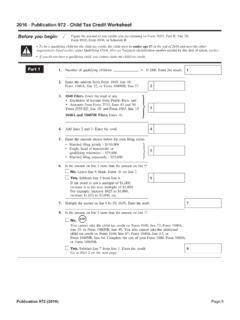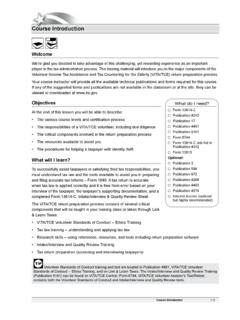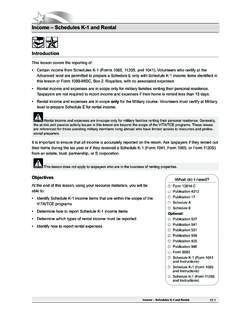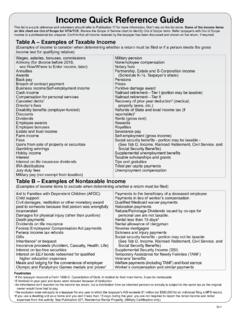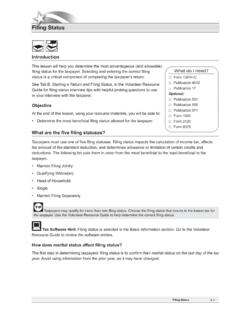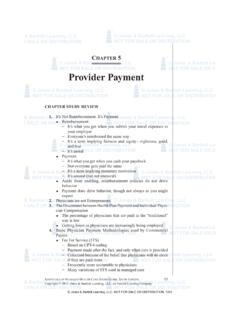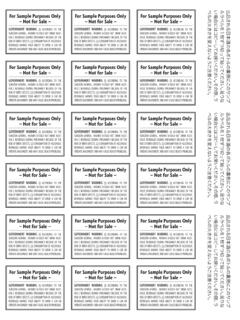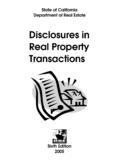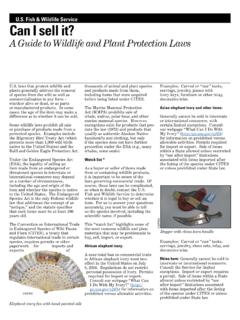Transcription of Introduction Objectives Topics - Internal Revenue Service
1 Page 1 Income capital gain or Loss Time Required: 30 minutes Introduction Objectives Topics This lesson is designed to teach volunteer tax preparers how to use form 1040, form 8949, and Schedule D, to report capital gains and/or losses on the sale of assets. This lesson includes Topics on the sale of stock, mutual funds, and the sale of a personal residence. Compute the adjusted basis of a stock or other investment property. Determine if an asset s holding period is long-term or short-term. Calculate the taxable gain or deductible loss from the sale of stock. Determine if a home is the taxpayer s main home. Determine if a taxpayer meets the ownership and use tests. Determine when the 5-year ownership/use test period is suspended. Reporting capital gain or loss Basis of Stock Holding period Proceeds from the sale form 8949 and Schedule D capital loss carryovers Sale of main home Main home Ownership and use tests gain on sale of main home Reporting gain from sale of home 5-year test period suspension Key Terms Adjusted Basis: The taxpayer s basis in a home increased or decreased by certain amounts.
2 Increases include additions or improvements to the home such as installing a recreation room or putting on a new roof. In order to be considered an increase, the improvement must have a useful life of more than one year. Repairs that maintain the home in good condition are not considered improvements and should not be added to the basis of the property. Amount Realized: The selling price minus selling expenses: commissions, advertising fees, legal fees, and loan charges paid by the seller, such as points). Basis: The basis in a property is determined by how the taxpayer obtained the property. If a taxpayer bought or built a home, the basis is what it cost the taxpayer to buy or build that home. If the taxpayer inherited the property, the basis is its fair market value on the date of the decedent s death, or on the later alternate valuation date chosen by the representative for the estate. There are special rules for determining the basis of property received from decedents who died in 2010.
3 capital gain Distributions: capital gains passed to investors typically by mutual funds (regulated investment companies) and real estate investment trusts (REITs). capital Loss Carryover: A taxpayer cannot take net losses of more than $3,000 ($1,500 for married taxpayers filing separately) in figuring taxable income for any single tax year. The allowable loss is referred to as the deduction limit. Unused losses can be carried over to later years until they are completely used up. The carryover losses are combined with the gains and losses that actually occur in the next year. Income capital gain or Loss page 2 Dividends: A corporation s distributions to its shareholders from its earnings and profits. DRIP Accounts: DRIP accounts leave cash dividends with the company for the purchase of additional shares. Even though these shares are from the same company, they retain their own individual basis separate from the original purchase. Each new purchased share could have a different basis.
4 Excludable Income: Income that is not included in the taxpayer s gross income and therefore exempt from federal income tax. Certain income may be exempt from tax but must be reported on the tax return. First-time Homebuyer Credit: This credit is an expired provision. It provided first-time homebuyers with a maximum credit of $8,000 ($4,000 for Married Filing Separately). This was a refundable credit, meaning that even if the taxpayer did not owe any tax, the money would be refunded to the taxpayer. There are recapture provisions if the home was sold or rented within a 36-month period. Five-year Test Period Suspension: Taxpayers can choose to have the five-year test period for ownership and use suspended during any period the homeowner (either spouse if married) served on qualified official extended duty as a member of the uniformed services or Foreign Service of the United States, as an employee of the intelligence community, or as an employee or volunteer of the Peace Corps.
5 This means that the taxpayer may be able to meet the two-year use test even if the taxpayer and/or spouse did not actually live in the home during the normal five-year period required of other taxpayers. Holding Period: form 8949 requires entries for the stock purchase and sale dates. By entering both dates, the software automatically determines the holding period; either short-term or long-term. Main Home: A taxpayer s main home is where they live most of the time. It does not have to be a traditional house; for example, it may be a houseboat, mobile home, cooperative apartment, or condominium, but it must have cooking, sleeping, and bathroom facilities. Mutual Fund: A mutual fund is a regulated investment company generally created by pooling funds of investors providing the advantage of a diversity of investments and professional management. Qualified Principal Residence Indebtedness: Any debt incurred in acquiring, constructing, or substantially improving a principal residence and which is secured by the principal residence.
6 Qualified principal residence indebtedness also includes any debt secured by the principal residence resulting from the refinancing of debt incurred to acquire, construct, or substantially improve a principal residence but only to the extent the amount of the debt does not exceed the amount of the refinanced debt. Sale of Main Home: Only a gain from the sale of a taxpayer s main home may be excluded from the taxpayer s income; a gain from a sale of a home that is not the taxpayer s main home will generally have to be reported as income. Selling Price: The total amount the taxpayer (seller) received for his or her main home. It includes money, all notes, mortgages, or other debts taken over by the buyer as part of the sale, and the fair market value of any other property or services that the seller received. Stock Dividends: Stock dividends merely increase the taxpayer s number of shares in the company and generally are not taxable. Stock Split: A stock split is a method used by corporations to lower the market price of stock.
7 A two- for-one stock split will decrease the basis per share by half. The original basis of $200 for 100 shares becomes $200 for 200 shares. Wash Sale: A wash sale occurs when a taxpayer sells or otherwise disposes of stock or securities (including a contract or option to acquire or sell stock or securities) at a loss and, within 30 days before or after the sale or disposition, the taxpayer buys, acquires, or enters into a contract or option to acquire substantially identical stock or securities. Income capital gain or Loss page 3 Teacher Tips Guidelines for Lesson Guideline Instructor Notes Presentation Aids Lesson background info Review the online demo of TaxSlayer on reporting capital gains and losses. TaxSlayer Demo: From the Practice Lab, select : TaxSlayer IRS training Click the appropriate demo Provide details and engage the students Discuss all tips and cautions in detail. Ask students to read and/or role-play examples and sample interviews.
8 Internet: Link & Learn Taxes (L<) Income capital gain or Loss Topic-specific Tips Topic Name Instructor Notes Presentation Aids Introduction Review lesson Objectives . Review list of references. State the presentation time. Review the Key Terms in the lesson. Point out that taxpayers often receive form 1099-B when they sell stocks. Taxpayers must report all sales of capital assets on form (s) 8949 and Schedule D, even if a form 1099-B is not received. Visuals: form 8949, pages 1 and 2 Schedule D Forms 1099-B, 1099-DIV, 1099-S form 1040 form 13614-C, Page 2, Part III Pub 4012, Tab D, Income: Schedule D capital Gains Internet: Tax Topics : capital Gains and Losses Income capital gain or Loss page 4 Reporting capital gain or loss Prompt students to share what they know about reporting capital gains and losses using questions from the topic. Direct students to Pub 4012, Entering capital Gains and Losses. Review flowchart in Pub 4012, Tab D, Income.
9 Ask: What is cost basis? What is the holding period? (When did you buy it and when did you sell it?) What is sales price? Visuals: form 8949, page 1 (short-term transactions), page 2 (long- term transactions) Schedule D form 1099-B Pub 4012, Tab D, Income: Entering capital Gains and Losses Schedule D capital gain or Loss Basis of Stock Review L< topic Basis of Stock. Ask students to define basis and adjusted basis. Emphasize that form 1099-B may not include how much taxpayers paid for the stock; if the form 1099-B does not provide the basis, taxpayers must provide this information. Remind volunteers they may provide assistance if taxpayers know the basis of property that was inherited or received as a gift. Otherwise, refer them to a professional tax preparer. Caution students that if a taxpayer acquired property from a decedent who died in 2010, special rules may apply. Visual: form 1099-B Pub 17, Basis of Property chapter Income capital gain or Loss page 5 Holding period Review L< topic Holding Period.
10 Ask: What are the short-term and long-term time periods? Answer: 1 year or less is short- term and more than 1 year is long-term. Ask: Why is it important to determine long vs short-term? Answer: Short-term gains are taxed at regular income tax rates; long-term are taxed at a lower rate. Ask: When does the holding period begin? Answer: The day after the shares were purchased. Review determination of gain or loss on the disposition of mutual fund shares. Review with students holding periods for sales of stock in blocks. Blocks of Stock is covered in the section of the lesson Holding Period, Long-term or Short-term. Visuals: Forms 1099-B, 1099-DIV, 1099-S Schedule D Pub 17, Sale of Property chapter Pub 550 Income capital gain or Loss page 6 Proceeds from the sale Review L< topic 1099-B Proceeds from the Sale. Brokers must report on form 1099-B: Cost or other basis, unless the securities sold were noncovered securities Whether the gain or loss is short-term or long-term, unless the securities sold were noncovered securities.
